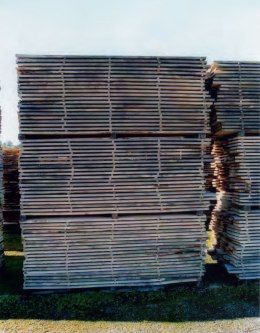
This is an excerpt from “Cut & Dried: A Woodworker’s Guide to Timber Technology” by Richard Jones.
Seasoning and drying of wood describe the same thing: reducing the moisture content of boards or planks thus bringing them into a dry-enough condition to use.
Acclimatising already-dried wood (acclimating in U.S. parlance) to the conditions in your workshop, or bringing it to a condition where it suits its final location as a piece of furniture or woodwork, is a different process to seasoning or drying wood. This subject (is) covered in section 6.12, Allowing for Changes in Wood Moisture Content.
There are several advantages of using dried wood.
Drying wood:
• Reduces its weight.
• Increases its strength and stiffness.
• Pre-shrinks it.
• Makes it more pleasant to handle.
• Reduces the chance of insect pest infestation leading to wood damage.
• Reduces warp and distortion of the wood in service because the drying process largely reveals any such tendencies in advance of constructing furniture and other wooden artefacts.
• The resin of resinous softwoods is hardened during higher temperature stages of the drying process in conventional kilns, making the resin less likely to weep out onto the surface of finished work.
• The end result of most machine and hand-tool operations are more predictable.
• Paints and polishes adhere better to dry wood.
• Modern adhesives formulations, in nearly every case, work best on dry wood.
• Wood preservatives and fire retardants penetrate dry wood better.
• Dry wood doesn’t spread damp to adjacent materials and objects.
• There is no fungal activity in wood dried to below 22 percent MC.

Apart from traditional green woodworking briefly described in section 6.9, there are some situations where undried wood has distinct advantages:
• It’s easier to drive screws, staples and nails into undried wood, and the wood is also less likely to split during nailing, although wood shrinkage may later lead to splitting.
• Screws, staples and nails driven into wet wood go rusty and this increases their holding power. Pallet and potato box manufacturers use partially dried wood for this reason.
• Cutting, shaping and working the wood requires less power, a characteristic often taken advantage of by carvers, turners, in steam bending, green woodworking etc.
The preferred moisture content of wood varies with its planned end use (see section 6.10) but to summarise, about 19 percent MC suits outdoor wooden artefacts; wood for internal furniture in the U.K. should generally be made out of material between about 7 and 12 percent MC. This MC range suits typical seasonal RH values for most British habitable buildings, i.e., about 35 percent RH in winter to 65 percent RH in summer. These numbers are similar to those experienced in coastal regions of North America. On the other hand, in central and northern areas of North America, the typical RH of habitable buildings tends to be somewhat lower at about 20 percent RH in winter (which assumes no artificial humidification system is installed in the building to maintain higher RH values) to 50 percent RH in summer, equating to wood MC values of 5 percent to 9 percent MC. Wood at various moisture contents between 12 percent and 18 percent is suitable for a variety of construction work and joinery in heated sheltered locations, sheltered unheated locations and for exterior joinery.
The two most common methods for drying wood are air drying and kiln drying. The methods are often used in conjunction. For example, it’s a common practice to partially air dry and follow up with a kiln-drying cycle. Within the two broad categories of air drying and kiln drying there are sub-categories. Air drying, for instance, breaks down into traditional air drying, accelerated air drying, forced air drying, low-temperature warehouse pre-drying and drying in climate chambers.

Kiln dryer configurations and types are varied. Conventional medium-temperature kiln drying is the first and predominant form. Conventional kilns, by definition, operate at temperatures below 100 degrees C or 212 degrees F. The second most common kiln type is the low-temperature dehumidification drying kiln. The smallest versions of this type can generally only reach a high temperature of about 115 degrees F (46 degrees C), but large units will easily achieve 150 degrees F (65.5 degrees C). Thirdly, there is solar kiln drying. Lastly there are progressive kilns, which are uncommon – the only working ones I am aware of in the U.K. at the time of writing are owned by BSW Timber. With the exception of progressive kilns, a kiln is loaded and closed. A drying cycle is run through and then the kiln is emptied, ready for another batch.
— Meghan B.